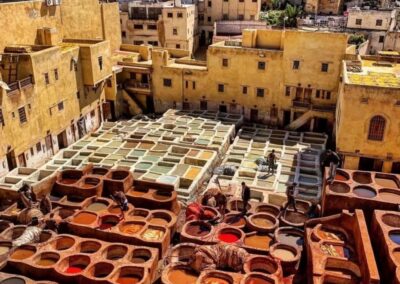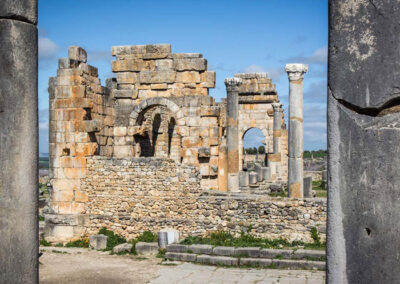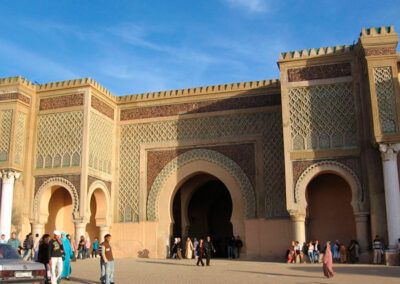Fes Day Trip to Meknes and Volubilis
Duration
Max People
10
Min Age
+5
Tour From
Fes
Introduction
Step back in time and traverse the rich tapestry of Morocco’s history as we embark on a captivating journey to two of its most storied destinations: Meknes and Volubilis. These enchanting sites weave tales of ancient civilizations, imperial grandeur, and the echoes of bygone eras. Meknes, with its imperial heritage, stands as a testament to the opulence of Moroccan dynasties. Meanwhile, Volubilis, an archaeological marvel, unveils the remnants of a Roman city frozen in time. Join us as we explore the cultural treasures, architectural wonders, and the timeless allure that Meknes and Volubilis offer, painting a vivid picture of Morocco’s fascinating past.
Detailed Itinerary Day Trip from Fes to Meknes and Volubilis
Pick-up from Fes (8:00 AM)
Your driver will meet you at your accommodation or the airport in Fes, ready to begin your adventure. You’ll embark on a scenic drive through the Moroccan countryside toward Meknes, a journey that will take approximately 2 hours.
Arrive in Meknes (10:00 AM)
Exploring the Medina of Meknes Upon arrival, you’ll be introduced to the charming city of Meknes, once the capital of Morocco during the reign of Sultan Moulay Ismail in the 17th century. Start your exploration by walking through the quaint, narrow streets of the old medina, where history and culture are alive in every corner. Your guide will point out the city’s most significant landmarks, providing insights into its rich heritage.
Visit the Shrine of Moulay Ismail (10:30 AM)
Your first stop will be the shrine of Moulay Ismail, the ruler who transformed Meknes from a small town to a grand imperial city. Located near the northern Bab Berdaine gate, this peaceful site is a tribute to one of Morocco’s most influential sultans. You’ll explore the shrine and learn about the sultan’s efforts to create one of the most powerful cities in North Africa during his rule.
Wander through the Historic Public Buildings (11:00 AM)
Meknes is home to many beautifully preserved public buildings, some hidden in the labyrinth of narrow streets. You’ll visit the old souk, where local crafts and goods are sold, and the granary of Moulay Ismail, a massive structure that once stored grain for the city’s citizens and military. The architecture is ornate, and the building’s significance will be explained by your guide.
Bab Mansor Gate and El-Hdim Square (12:00 PM)
Next, you’ll head to one of the most iconic landmarks in Meknes—the Bab Mansor Gate. This majestic gate, with its intricate carvings and impressive size, stands proudly at the entrance to El-Hdim Square, a lively space that’s often compared to Marrakech’s Jamaa El-Fna Square. You’ll have some time to admire the architecture and take in the atmosphere of the surrounding area.
Lunch Break (1:00 PM)
After a morning of exploration, you’ll enjoy a traditional Moroccan lunch at a local restaurant in Meknes, where you can taste regional specialties such as tagine, couscous, or pastilla.
Drive to Volubilis (2:00 PM)
Explore the Ruins of Volubilis (2:30 PM) Following lunch, you’ll drive about 30 minutes to the archaeological site of Volubilis. Situated at the foot of the Zerhoun Mountains, this UNESCO World Heritage site is one of Morocco’s most significant ancient Roman ruins. As you walk through the sprawling site, you’ll marvel at the remarkably well-preserved mosaics, triumphal arches, and remnants of Roman villas. Your guide will bring the history of this ancient city to life, explaining its role as a thriving Roman outpost during the 3rd century.
Return to Fes (4:30 PM)
After exploring Volubilis, you’ll begin your journey back to Fes, where your driver will drop you off at your accommodation or the airport.
Arrive in Fes (6:30 PM)
End of the Day Trip
This day trip offers a fantastic opportunity to experience two of Morocco’s most historically rich destinations, from the imperial charm of Meknes to the ancient splendor of Volubilis.
Note: The timing outlined in the itinerary is flexible and can be adjusted to suit your preferences and needs. Whether you require an earlier start, additional stops, or extra time at specific locations, we are happy to customize the schedule to ensure your experience is as comfortable and enjoyable as possible.
Included
Excluded
More Information:
Tour Costs
Our tour rates are quoted in USD per person, based on the number of travelers in your booking. These rates are valid throughout the year, except during peak periods like Christmas and New Year. Prices vary depending on the group size, with options tailored to solo travelers, couples, families, and larger groups to ensure the best value for everyone.
Children’s Policy
We welcome families and offer special discounts for younger travelers:
- Ages 0–5: Travel free of charge.
- Ages 6–11: Enjoy up to a 50% discount, depending on the chosen tour.
- Ages 12+: Charged as adults.
This policy ensures that your family can explore Morocco together affordably, with discounts reflecting the age of younger guests.
Booking Your Tour
Booking a tour with us is quick and easy:
- Please choose your preferred tour from our selection.
- Click the “BOOK THIS TOUR” button on the detailed tour page.
- Enter your travel dates, and the number of travelers in your group, and complete the booking process to confirm.
Visit Chaouen on a day trip from Fes. Chefchaouen, a village in the Rif, captivates with its narrow streets, blue-washed walls, tiled roofs, and intricate wrought-iron windows.
Map of the Day Trip from Fes to Meknes and Volubilis
Meknes: The City of Moulay Ismail
Meknes is a city that showcases the legacy of Sultan Moulay Ismail, whose reign in the late 17th century was marked by military success, economic growth, and the construction of grand architectural works. Under his leadership, Meknes became an imperial city designed to rival the best cities of the Maghreb and beyond. His impact is still visible today in the monumental gates, royal palaces, and fortifications that define the city.
- Bab Mansour: Arguably the most famous landmark in Meknes, this monumental gate was constructed by Moulay Ismail to provide access to the royal palace. Known for its intricate mosaic work and towering structure, Bab Mansour is a symbol of the grandeur of the sultan’s vision.
- Moulay Ismail’s Mausoleum: This sacred site, located near Bab Berdaine gate, is the final resting place of the sultan himself. The mausoleum is a beautiful example of Islamic architecture, with its detailed tilework and tranquil ambiance. It’s also a popular destination for pilgrims, as Moulay Ismail is highly revered in Morocco.
- Royal Stables and Granaries: Moulay Ismail’s ambition didn’t stop at grand gates and palaces; he also built massive stables and granaries to supply his army and the city. The stables were once home to thousands of horses, and the granaries stored food to sustain the city’s population. Today, these sites serve as a reminder of the sultan’s strategic foresight.
Volubilis: The Roman Legacy
A short drive from Meknes brings visitors to the stunning ruins of Volubilis, one of Morocco’s most significant archaeological sites. Established in the 3rd century BCE, Volubilis was once a thriving Roman city. The site is home to spectacular mosaics, triumphal arches, and the remains of Roman villas, offering a fascinating insight into Morocco’s role as a key part of the Roman Empire. Volubilis is recognized as a UNESCO World Heritage site and provides a unique juxtaposition to the imperial grandeur of Meknes, showcasing the region’s long and diverse history.
Moulay Idriss Zerhoun: The Sacred City
Just 20 kilometers from Meknes lies Moulay Idriss Zerhoun, one of the most important spiritual sites in Morocco. This small town is named after Moulay Idriss I, the founder of the Idrisid dynasty, who brought Islam to Morocco in the 8th century. His tomb, located at the top of a hill in the town, is a place of pilgrimage for Moroccans, and the town itself is considered sacred.
- Moulay Idriss I’s Tomb: The most significant site in the town is the mausoleum of Moulay Idriss I, which attracts pilgrims from all over Morocco and beyond. It is said that the town was founded by the sultan himself, and his tomb is considered one of the holiest in the country. Visitors can see the tomb and learn about the life of this revered figure, who played a pivotal role in shaping Moroccan history.
- The Town of Moulay Idriss Zerhoun: Perched on the slopes of Mount Zerhoun, the town offers panoramic views of the surrounding countryside. The streets are narrow and winding, with whitewashed buildings that give the town a timeless, tranquil feel. The sacred nature of the town means that only Muslims are allowed to enter the tomb of Moulay Idriss, but the surrounding area offers plenty of opportunity for reflection and appreciation of Morocco’s spiritual heritage.
Connecting the Sacred and the Imperial
Meknes and Moulay Idriss Zerhoun are both deeply connected to the broader history of Morocco, but they offer different experiences. While Meknes impresses with its imperial architecture and the legacy of Sultan Moulay Ismail, Moulay Idriss Zerhoun offers a more intimate, spiritual experience. Together, they form a rich tapestry of Morocco’s historical, cultural, and religious heritage.
The proximity of these two places allows visitors to experience both the grandeur of an imperial city and the sacredness of a town that is central to Morocco’s religious and spiritual identity. Whether wandering through the streets of Meknes, marveling at its gates and palaces, or reflecting at the tomb of Moulay Idriss in Zerhoun, travelers will find that both cities reveal a deeper understanding of Morocco’s fascinating past.



